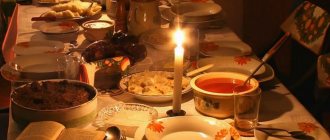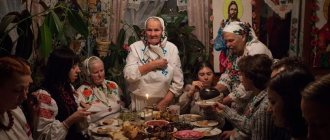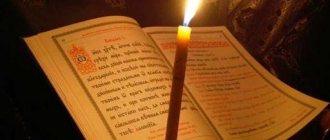Funerals are a long-standing tradition where we “see off” the deceased at a meal.
Reference! It is worth mentioning that the funeral was originally a pagan tradition, however, Christianity failed to supplant it. Moreover, it organically incorporated this tradition into its own.
Our ancestors have been performing funerals since time immemorial. Such customs can be seen in a variety of religions and denominations, among different peoples. The tradition of “seeing off” the dead is associated with the belief of many people in the soul and its immortality.
A wake does not simply mean a lunch or meal, rather it is a special ancient ritual. Its main goal is to remember a person, about his good deeds and “help” him in the afterlife.
In some regions, it is customary to enter a funeral without an invitation. Those who want to pay tribute to the deceased come, in others - strictly by invitation, without “extra” people.
Commemoration of the dead in Orthodoxy
Commemoration of the dead is a special custom among Orthodox Christians. In Orthodoxy, the numbers 3, 9, 40 have sacred meaning, so these days are special for commemoration. According to church traditions, after death you need to remember a person in order to help the deceased find peace with your prayers. After leaving earthly life, the soul of the deceased is in search of its path to a new life. She is looking for her new home in the other world. By remembering a person and praying for him, neighbors ease the fate of the deceased and help the soul find peace.
What dishes to prepare for Lent?
A common Lenten memorial dish during Christmas or Lent is cabbage soup.
How to cook delicious lean cabbage soup with mushrooms?
- First you need to cook broth from mushrooms (about 2 liters).
- Next, pour about 0.5 kg of sauerkraut with boiling water (about half a liter) and put it in the oven for half an hour at a temperature of 140 degrees.
- Then pour in a few tablespoons of sunflower oil, add some dill and coriander seeds.
- Heat this mixture for about five minutes, but do not fry!
- After this, remove the seeds and add two chopped onions to the oil along with the cabbage.
- Next you need to pour a small amount of buckwheat (2-3 tablespoons) into our broth.
- We also add one carrot and two potatoes, after cutting the vegetables into cubes. Cook for half an hour.
- At the end, add finely chopped garlic (amount to taste), onion and cabbage to the broth. Cook for 20-30 minutes. Lenten cabbage soup is ready.
Reference! Wednesday and Friday of each week are considered fast days, since on Wednesday Christ was betrayed and crucified on Friday, so the funeral table on these days should be modest.
Funeral service for 9 days after death
In Orthodoxy, Christians have a tradition of honoring the memory of the deceased for nine days from the moment of departure. There are special customs for remembering the deceased, which are extremely important to observe, because these are traditions established over time. Adhering to these traditions and rituals is important not only from a religious point of view, but also for the peace of mind and balance of the family of the deceased.
Necessary funeral rituals for 9 days after death:
- going to church;
- performing a service (memorial service, lithium, funeral service, magpie);
- reading a prayer (in church or at home);
- visiting a grave;
- funeral lunch.
Menu for home table
Since the times of Rus', traditional dishes have been served at funerals, such as kanun (fullness), kutya, jelly and pancakes.
They try to make the funeral table varied and richly set. As a rule, hot and cold meat (and fish) dishes are served. Pies are a common dish.
Reference! It is highly desirable to have an even number of dishes.
On the first
is perfect for a hot first course .
Preparation:
- To prepare it you will need meat broth (you can have it on the bone).
- When the meat is cooked, you should start frying the vegetables.
- Add finely chopped onion to a heated frying pan with sunflower oil.
- While it is frying, you need to cut the carrots and beets into cubes. Next, we also add these vegetables to the frying pan.
- While our vegetables are fried, we also cut the potatoes into cubes and add them to the broth.
- While the potatoes are cooking, add our vegetables from the frying pan to the broth.
- Next, cut the cabbage, tomatoes, and sweet peppers into cubes.
- Add the remaining ingredients to the broth.
- Additionally season our borscht with black pepper, add bay leaf and garlic to taste.
- A little vinegar and sugar won't hurt.
Hot dish
First prepare the minced meat. Next, grate the onion, garlic and mix the ingredients in one bowl along with the eggs, salt and pepper. Then knead until smooth.
Place our formed cutlets . Fry them on both sides. Next, pour a little oil into the pan and add the cutlets there. Fill half the layer of cutlets with water and simmer until evaporated.
For a snack
Beetroot and garlic salad is quite easy to prepare:
- We pre-wash the beets, but do not peel them. Wrap in foil and bake in the oven at a temperature of about 180 degrees. Baking time - from 60 to 80 minutes (this depends on the size of the vegetable). You can also boil it.
- Next, grate the beets, garlic and cheese.
- Add mayonnaise, salt and spices to taste to the ingredients.
- Chopped nuts or raisins are perfect for this salad.
- All that remains is to mix the salad and serve it to the table.
Dessert
To prepare puff pastries , we need puff pastry and filling (it can be apples, cottage cheese, bananas, and so on).
Why do funerals last for 9 days?
The commemoration of the deceased is held for 9 days after death in honor of the nine angels who protect the soul of the deceased and ask the Almighty for its salvation. Following Orthodox tradition, the purpose of a memorial service is to help the deceased find his new home. The ninth day after a person’s departure is a very important period for family and friends. According to church customs, the transition of the soul of the deceased to the Kingdom of Heaven depends on them. With their prayers, relatives can help the soul of the deceased find peace.
Who is invited
Traditionally, nine days of wakes are considered uninvited. It is important that people come of their own free will. Inviting or reminding about this date is not customary in Orthodox traditions. However, in the modern world, people are often invited to funerals in order to plan and resolve organizational issues in advance. Sometimes the relatives of the deceased themselves casually remind about this event, thereby, without breaking traditions, they warn in advance about their arrival. If a large number of people are expected, then the memorial is held outside the home, for example, in a restaurant.
- How to clean a carpet
- How to convert pdf to jpeg format. How to convert files or documents online or using a program
- Stuffed potatoes - recipes with photos. How to cook stuffed potatoes in the oven or slow cooker
What's being cooked
The most common dish that is prepared for a funeral for 9 days is kutia: boiled wheat seeds, to which something sweet is added, such as sugar or honey. Seeds are a symbol of life, and sugar or honey is the sweetness of life after death. Instead of kutya, you can prepare another porridge, for example, rice. It is customary to place compote or jelly on the funeral table for 9 days. Sometimes at funeral meals you can see pancakes, pies, various fish dishes, cutlets, and also borscht. According to Orthodox customs, the funeral meal should be without alcohol.
What to do for 9 days
Commemoration for 9 days after death is the day when the deceased is remembered and only good things are remembered about him. During this period, it is not customary to organize mourning gatherings or, conversely, to organize a joyful feast. It must pass quietly, and the family of the deceased must behave humbly. In addition, there are a large number of different customs that need to be taken into account.
Funeral customs 9 days:
- There should be a slice of bread and a bowl of water at home from morning to night.
- You need to light a candle or lamp next to the photograph of the deceased.
- You need to visit the cemetery of the deceased, but you cannot arrange a funeral right in the middle of the cemetery.
- The funeral meal should be modest, without excesses.
- Food left over after a funeral meal should not be thrown away. The remaining food should be distributed to the poor and homeless people.
- On this date, you need to give out alms, give lunches to the poor, and help those in need.
Prayer
Correctly commemorating the departed on the 9th day means praying for them. Despite the pain and bitterness of loss, you need to realize that prayer will help the deceased more than tears. It is important to let go of your loved one so that his soul can find peace in the afterlife. It is extremely necessary to pray for the mercy of the Almighty towards the deceased, because if they pray for the deceased, it means there is something good in him. Therefore, it is important to visit the temple and order a magpie for the departed. Before the funeral meal, it is extremely necessary to read the rite of lithium about the deceased.
When should you remember the deceased?
According to rituals and traditions, in our area, funeral services are held three times.
The first wake is done right on the day of the funeral , in other words, on the third day (starting from the day of death):
- According to Orthodox doctrine, for the first two days the soul of the deceased still remains on earth and is with loved ones and relatives.
- The soul is accompanied by angels and shown places that are significant to it, reminding it of good and evil deeds.
- On the third, the time comes for the soul to appear before God.
- At the funeral table, prayers are usually performed; it is unacceptable to laugh, remember the bad deeds of the deceased, or use obscene language.
The second funeral rite is usually performed on the ninth day.
After three days, the soul, along with the angels, goes to heaven and observes their beauty and bliss. She is shown this world for about six days.
Finally, on the ninth day, the soul meets God again. The prayers that are said at the funeral table on this day help the soul to pass these tests with dignity.
Well, the last wake, the third, is performed on the fortieth day.
Later, a wake is held a year later, that is, on the anniversary of death.
Attention! It is already permissible for the last wake to be attended by everyone who has a desire to honor the memory of the deceased.
When and how to remember a deceased person is explained in the video:
How to count 9 days after death
According to Christian canons, commemoration on the 9th day after death is an important event, so you need to correctly calculate the date on which it falls. In order to correctly count nine days, you need to start the report directly from the day the deceased left. The first day should be considered the day of death itself, and not the funeral. Nine days inclusive from the moment of death must be counted only if death occurred before midnight. If the death occurred after midnight, then they begin to count from the next day inclusive.
Mandatory funeral dishes
The main dish of all funeral dinners is kutia - a symbol of the rebirth of the soul of the deceased. Each person present at the funeral table must eat his portion (at least 3 spoons) before starting other dishes.
Kutya is a porridge cooked from wheat grains (sometimes they can be replaced by whole grains of barley, oats, rice, peas and pearl barley), which also includes honey, raisins and nuts. The whole grain in this dish symbolized rebirth and the eternal afterlife.
Kutia is the main dish on the funeral table and must be consecrated in the church after the funeral or funeral service. You can also sprinkle the kutya with holy water before serving.
Preparing funeral kutia from rice is simple. For this we take:
- 0.5 cups steamed rice;
- 1 tablespoon honey;
- 100 grams of raisins;
- 50 grams of dried fruits (dried apricots, prunes);
- 2 glasses of water;
- 20−30 grams of walnuts;
- vanilla sugar on the tip of a knife.
Before cooking rice, it should be soaked for 2-3 hours to remove excess gluten and starch. Drain the water, transfer the rice to fresh cold water, and cook until done like regular crumbly porridge. In order for the honey to be well absorbed into the grain, it should be melted in a water bath. And the sweet and dry ingredients of kutya are added at the end. Stir and let stand for 10-15 minutes so that the dried fruits steam.
After kutya, guests are served Lenten memorial pancakes and sweet honey jelly with milk .
Pancakes, like jelly, are not just a dish; their appearance on the table on Memorial Day is deeply symbolic. Pancakes have great ritual significance; they are a symbol of eternal immortality and resurrection, and represent the sun.
To prepare ordinary funeral pancakes you will need:
- 0.5 liters of warm water or milk;
- 500 grams of wheat flour;
- 2 eggs;
- 25 grams of vegetable oil or butter;
- ½ teaspoon salt, sugar and soda.
Mix flour, eggs, salt, sugar with warm water or milk. Knead into a homogeneous dough without lumps, add soda. Bake in a well-heated frying pan in vegetable oil.
Kissel (made from oats, rye or wheat) with milk symbolizes milk rivers and jelly banks in the other world. Kissel ends the funeral dinner and is served to the guests last. To cook funeral oatmeal jelly you will need:
- 2 cups oatmeal;
- 1.5 liters of boiled water;
- 1 crust of black bread.
Pour boiled water over the oatmeal, dip a crust of black bread into the liquid so that the jelly ferments. After the jelly has fermented after two days, it needs to be strained, brought to a boil and sweetened with honey.
In addition to ritual dishes, you can prepare the following for the funeral table:
- Hot dishes include cabbage soup, borscht, chicken noodle soup, meat dishes (cutlets, roasts), fish, buckwheat porridge, stuffed peppers, and boiled potatoes.
- Served as appetizers: cucumber and tomato salad, feta cheese with tomatoes, vinaigrette with herring.
- You can also bake a pie or filled pies, gingerbread cookies, pancakes, and gingerbreads from the dough.
Of course, the composition of the dishes largely depends on the family structure, wealth and traditions, the number of people who will come to the funeral and other decisive factors. But, it should be remembered that the set of dishes should be as simple as possible, as if setting a regular dinner table on Sunday.
Sample menu for a funeral at home
Funeral table option:
- Kutya, Lenten pancakes and jelly (are a mandatory treat at a funeral dinner).
- Sandwiches with fish (red fish or sprats).
- Beet salad with garlic.
- Vegetable salad with vegetable oil.
- Baked cutlets with cheese and mushrooms or cabbage rolls.
- Beetroot borscht.
- Pie with filling (fish, rice and mushrooms, potatoes, apples).
- Drinks that are perfect include: jelly (oatmeal, currant, cranberry), sbiten, fruit drink or kvass on bread.
- Fish jelly.
- Tea, sweets.
A funeral dinner is not a social event or a feast, and should not be considered as an occasion to gather with friends and relatives for idle communication and discussion of everyday issues. Therefore, the Christian Church prohibits fun, alcohol and music, so that the funeral meal does not turn into a noisy feast.
Funeral - from the word remember. This is an ancient Orthodox rite aimed at helping a suffering soul find a better world.
After all, what is important is not the fact of the funeral dinner itself, but the fact that people who cared about the deceased came to it, and what is important is that they gathered together at one table to support each other in their grief.











